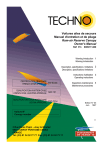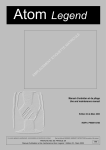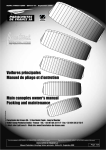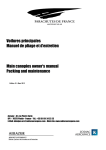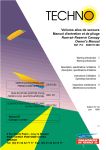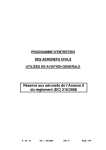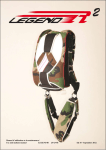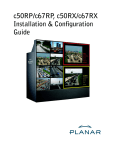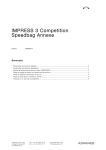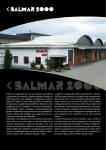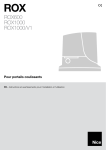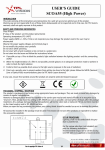Download Voilures ailes de secours Manuel d`entretien et de pliage Ram
Transcript
732 031 349 RCS Pontoise voilure N°: ...................................... Canopy N°: Voilures ailes de secours Manuel d'entretien et de pliage Ram-air Reserve Canopy Owner's Manual Réf P/n P9009111400 Edition N° 05 de Novembre 2000 Conformément à la FEE N° 193 Validée en date du 24/10/2000 CERTIFICATION FRANCAISE FRENCH SPAE APPROVAL QUALIFICATION AVIATION CIVILE FRENCH AVIATION APPROVAL QUALIFICATION CIVILE AMERICAINE US FAA APPROVAL Lire, suivre, appliquer les avertissements , recomandations, et instructions de ce manuel 530 EQ 03 QAC 121 TSO C23d Read and follow all WARNINGS, WARRANTY, INSTRUCTIONS for products of this manual. PARACHUTES DE FRANCE SA Manuel d’entretien et de pliage Techno - Edition 05 - Novembre 2000 1/24 PARACHUTES DE FRANCE SA Voilure de secours Reserve canopy WARNING LE SPORT PARACHUTISTE EST UNE ACTIVITE À RISQUES DONT IL PEUT RÉSULTER DES BLESSURES OU LA MORT. LE DEVELOPPEMENT DES NOUVELLES DISCIPLINES DU SPORT PARACHUTISTE TELLES QUE LE FREE-FLY, LE FREE STYLE, LE SKY SURF ET LE KILOMETRE LANCE EN CHUTE CONDUIT FREQUEMMENT AU DEPASSEMENT DES LIMITES DE CERTIFICATIONS DES VITESSES DE DEPLOIEMENT DE VOTRE PARACHUTE. LES CONSEQUENCES DE TELS DEPLOIEMENTS A VITESSE SUPERIEURES AUX LIMITES DE CERTIFICATIONS PEUVENT ENTRAINER DE GRAVES BLESSURES OU LA MORT. 1. UN ENTRAINEMENT ET/OU UNE EXPERIENCE DU PARACHUTISME SONT INDISPENSABLES POUR REDUIRE LES RISQUES DE BLESSURE GRAVE OU DE MORT. NE JAMAIS UTILISER CET EQUIPEMENT AVANT D'AVOIR: A. LU ET COMPRIS CET AVERTISSEMENT ET SUIVI UN PROGRAMME D'INSTRUCTION SPECIFIQUE À CE TYPE DE MATERIEL. -OUB. LU ET COMPRIS CET AVERTISSEMENT, AINSI QUE TOUS LES MANUELS APPROPRIÉS, ET EFFECTUÉ AU MOINS 100 SAUTS AVEC UN PARACHUTE DU TYPE ‘’AILE’’. 2. POUR REDUIRE LES RISQUES D'OUVERTURE VIOLENTE, DE DOMMAGES, DE BLESSURE GRAVE OU DE MORT, NE PAS DEPASSER LES LIMITES INSCRITES SUR LE PANNEAU COUSU AU BORD DE FUITE DE LA VOILURE. 3. A. LES PARACHUTES PEUVENT QUELQUEFOIS DISFONCTIONNER,MÊME S’ILS ONT ÉTÉ CONVENABLEMENT ÉTUDIÉS, CONSTRUITS, ASSEMBLÉS, PLIÉS, CERTIFIÉS, ENTRETENUS ET UTILISÉS. LES CONSÉQUENCES DE TELS DISFONCTIONNEMENTS PEUVENT ENTRAINER DE GRAVES BLESSURES OU LA MORT. B. SI VOUS UTILISEZ VOTRE PARACHUTE, OU SI VOUS AUTORISEZ UNE AUTRE PERSONNE À L’UTILISER, VOUS AVEZ CONNAISSANCE DES RISQUES DU PARACHUTISME ET VOUS ACCEPTEZ LE FAIT QUE CE PARACHUTE OU SES COMPOSANTS PUISSENT DISFONCTIONNER. C. SI VOUS N’ACCEPTEZ PAS LES RISQUES DU SPORT PARACHUTISTE, OU SI VOUS N’ACCEPTEZ PAS LA POSSIBILITÉ QUE VOTRE PARACHUTE OU SES COMPOSANTS PUISSENT DISFONCTIONNER ET VOUS CAUSER DES BLESSURES OU LA MORT, VOUS DEVEZ ALORS RECONSIDÉRER VOTRE IMPLICATION DANS LE SPORT PARACHUTISTE. SPORT PARACHUTING IS A HAZARDOUS ACTIVITY THAT CAN RESULT IN INJURY OR DEATH. THE EXPANSION OF NEW WAYS OF SPORT PARACHUTING AS FREE-FLY, FREE STYLE, SKY SURF AND SPEEDSKYDIVING OFTEN INVOLVE TO EXCEED THE CERTIFICATION DEPLOYMENT SPEED LIMITS OF YOUR PARACHUTE ASSEMBLY. RESULTS OF SUCH CERTIFICATION DEPLOYMENT SPEED LIMITS OVERSTEPPING MAY BE INJURY OR DEATH. 1. TRAINING AND/OR EXPERIENCE ARE REQUIRED TO LOWER THE RISK OF SERIOUS INJURY OR DEATH. NEVER USE THIS EQUIPMENT UNLESS YOU HAVE: A. READ THIS WARNING LABEL AND COMPLETED A "CONTROLLED PROGRAM OF INSTRUCTION" IN THE USE OF THIS PARACHUTE ASSEMBLY. -ORB. READ THE WARNING LABEL AND ALL APPROPRIATE OWNERS/FLIGHT MANUALS PACKING INSTRUCTIONS AND COMPLETED AT LEAST 100 RAM-AIR PARACHUTE JUMPS. 2. LOWER THE RISK OF DEATH, SERIOUS INJURY, CANOPY DAMAGE AND HARD OPENING BY NEVER EXCEEDING THE LIMITS SHOWN ON THE LABEL LOCATED AT THE TRAILING EDGE. 3. A. PARACHUTES SOMETIMES MALFUNCTION EVEN WHEN THEY ARE PROPERLY DESIGNED, BUILD, ASSEMBLED, PACKED, MAINTAINED AND USED. THE RESULT OF SUCH MALFUNCTIONS ARE SOMETIMES SERIOUS INJURY OR DEATH. B. IF YOU USE YOUR PARACHUTE- OR IF YOU ALLOW SOMEONE ELSE TO USE IT-YOU ARE ACKNOWLEDGING SPORT PARACHUTING’S RISK AND ACCEPTING THE FACT THAT THE PARACHUTE OR ITS COMPONENTS MAY MALFUNCTION. C. IF YOU ARE NOT WILLING TO ACCEPT THE RISKS OF SPORT PARACHUTING, OR IF YOU AREN’T WILLING TO ACCEPT THE POSSIBILITY THAT YOUR PARACHUTE OR ITS COMPONENTS MAY MALFUNCTION AND PERHAPS CAUSE YOU TO BE INJURED OR KILLED, THEN YOU SHOULD RECONSIDER YOUR INVOLVEMENT IN SPORT PARACHUTING. Lire, suivre, appliquer les avertissements , recomandations, et instructions de ce manuel 2/24 Read and follow all WARNINGS, WARRANTY, INSTRUCTIONS for products of this manual. PARACHUTES DE FRANCE SA Manuel d’entretien et de pliage Techno - Edition 05 - Novembre 2000 PARACHUTES DE FRANCE SA Voilure de secours Reserve canopy SOMMAIRE CONTENTS 1 - PRESENTATION page 1.1 - Avertissement 1.1 - Introductory matter 4 1.2 - Introduction 5 1.3 - Description 6 1.4 - Spécifications techniques et limitations 1.4 - Technical specifications and limitations 7 2 - INSTRUCTIONS D’UTILISATION OPERATING INSTRUCTIONS 2.1 - Montage 2.1 - Assembly 8-9 2.2 - Pliage 2.2 - Packing 10 - 19 2.3 - Utilisation en vol 2.3 - In flight use 20 3 - INSPECTION & MAINTENANCE 3.1 - Vérification avant emploi 3.1 - Pre-flight use 21 3.2 - Périodicité 3.2 - Periodicity 21 3.3 - Inspection 3.3 - checking 21 3.4 - Maintenance 22 3.5 - Stockage 3.5 - Storage 23 Lire, suivre, appliquer les avertissements , recomandations, et instructions de ce manuel Read and follow all WARNINGS, WARRANTY, INSTRUCTIONS for products of this manual. PARACHUTES DE FRANCE SA Manuel d’entretien et de pliage Techno - Edition 05 - Novembre 2000 3/24 PARACHUTES DE FRANCE SA Voilure de secours 1 - Presentation Reserve canopy 1 - Presentation 1.1 - Avertissement: 1.1 - Introductory matter: - Lisez et suivez toute instruction d'opération et toute spécification, instruction, conseils et exigences du fabricant pour l'utilisation du matériel. - Read and follow all operating instructions and all manufacturer specifications, instructions, advises and requirements for use of the equipment. - Utilisez uniquement les composants d'origine PFSA. - Use only genuine PFSA components. - Examinez tout équipement et/ou matériel, y compris toute installation, toute boucle, tout mousqueton ou tout autre système d'attache avant chaque utilisation de tout produit relatif au parachute. - Examine and replace ANY defective, worn or deteriorated component. - Utilisez uniquement des produits conçus pour l'usage défini par PARACHUTES de FRANCE SA. - Use only those products designed for parachute use by PARACHUTES de FRANCE SA. - N’ excédez les forces, vitesses ou autres paramètres recommandés pour l'utilisation du matériel selon les règles de sécurité. - Do not exceed recommended or stated forces, speeds, or other factors regarding safe use of the equipment. - Lisez et respectez tout avertissement, manuel, instruction, recommandation, spécification d'entraînement ou d'expérience et toutes les procédures connues et enseignées concernant la pratique du parachutisme. - Read and follow all warning labels, manuals, instructions, training or experience requirements and recommendations and all recognised parachute use procedures. - Ne tentez jamais d'utiliser un matériel sans être sûr qu'il a été conditionné, préparé, assemblé ou monté selon les règles de l'art par une personne qualifiée. - Use equipment only when you are sure it was assembled, checked and packed by a qualified person. - Apprenez à connaître votre matériel et examinez-le avant chaque utilisation. - Get a complete knowledge of your equipment and check it before each use. IL Y A DANGER DE BLESSURE GRAVE OU DE MORT A NE PAS SUIVRE TOUS LES AVERTISSEMENTS, INSTRUCTIONS ET PROCEDURES REQUIS. FAILURE TO FOLLOW ALL WARNINGS INSTRUCTIONS AND REQUIRED PROCEDURES MAY RESULT IN SERIOUS INJURY OR DEATH. La plupart des situations dangereuses dues au mauvais état d'un composant de parachute naissent d'une attitude inconsciente si ce mauvais état est connu, négligente s'il est ignoré. Ne négligez donc pas les contrôles préliminaires qui vous sont conseillés à la section "maintenance " en fin de ce manuel. Dangerous situations arising from a defective parachute component are due to lack of attention when the defect is not known and to sheer negligence when it is. The recommended preliminary checks should therefore not be neglected. Do not "skip" the first few pages of this manual, as all the information given is important. If in doubt, do not hesitate to consult a specialist. ATTENTION: Aussi solide que soit votre expérience des parachutes de type aile, nous vous engageons à lire le présent manuel avant d'aller plus loin. CAUTION: However vast your experience with ram-air canopies may be, please read this manual before jumping. Lire, suivre, appliquer les avertissements , recomandations, et instructions de ce manuel Read and follow all WARNINGS, WARRANTY, INSTRUCTIONS for products of this manual. 4/24 PARACHUTES DE FRANCE SA Manuel d’entretien et de pliage Techno - Edition 05 - Novembre 2000 PARACHUTES DE FRANCE SA Voilure de secours Reserve canopy 1.2 - Introduction 1.2 - Introduction Cher client, Nous souhaitons tout d'abord vous remercier pour l'achat d'une voilure PARACHUTES DE FRANCE. Nous vous recommandons vivement d'inspecter ou de faire inspecter soigneusement votre voilure afin de vous familiariser complètement avec ses caractéristiques et de constater la qualité de sa fabrication. Si quoi que ce soit ne vous paraissait pas normal, merci d'avertir immédiatement PARACHUTES DE FRANCE SA. Dear customer, First of all, we would like to thank you for purchasing a reserve canopy from PARACHUTES DE FRANCE. We strongly recommend that you carefully inspect your canopy, or have it inspected, so as to get used to its caracteristics and check quality of its workmanship. If anything would seem abnormal to you, please contact your local distributor or PARACHUTES DE FRANCE SA. Comment choisir votre voilure de secours? Les voilures de secours TECHNO PFSA sont déclinées en différentes tailles. La surface et le type de la voilure sont indiqués sur le panneau marque cousu au bord de fuite sur le caisson central. Le choix d'un modèle se fait en fonction du poids, de l'utilisation, et de la technicité de l'utilisateur. Choisir une voilure de secours est un acte personnel. Toutefois, l'usage de la voilure de secours pouvant parfois se faire dans des conditions dificiles, nous vous recommandons de choisir une voilure confortable et pas trop petite. Les caractéristiques de vol d'une voilure sont la vitesse propre et la vitesse de descente. Ces deux éléments sont générés par le poids de l'utilisateur, qui est en quelque sorte le moteur. Plus le poids sera élevé, plus la vitesse sur trajectoire et la vitesse de descente seront grandes, plus la réponse aux commandes sera vive et PLUS LE DÉCROCHAGE SERA VIOLENT ET SANS AVERTISSEMENT. How to choose your reserve canopy ? The PFSA reserve canopies come in several surface areas. Surface and model are readable on the label stitched on the tail. A l'inverse, si le poids diminue, la vitesse propre et la vitesse de descente diminuent, la réponse aux commandes sera plus douce et lente, le décrochage sera plus doux et prévisible. On comprend qu'un poids trop élevé produira des vitesses propre et verticale trop grandes, difficiles à maitriser. A ce moment vous prenez un grand risque, car il sera malaisé d'obtenir un atterrissage en sécurité, surtout si les conditions sont difficiles. On the contrary, if the weight goes down, basic speeds go down too.The answer to toggles is softer, the stalling point more predictable. So, it is understandable that too much weight will generate too high speeds difficult to control. In this case you would take a big risk because it would be difficult to perform a safe landing, especially in demanding conditions. Quelle est la bonne surface pour votre poids? La charge alaire est obtenue en divisant la masse totale équipée par la surface de la voilure. On entend par masse totale équipé le poids du parachutiste plus son habillement et ses accessoires plus l'équipement plié prêt à sauter. Exemple: - Parachutiste 70 kg - Habillement+ accessoires 5 kg - Parachute 10 kg - Total 85 kg What is the right surface for your weight ? The wing load ratio is obtained by dividing the total weight of the jumper, plus his clothing and accessories, plus the weight of the rig ready to jump, by the surface of the canopy. Pour 17,70 m2 la charge alaire est: 85 / 17,70 = 4,8 kg/m2 For 190 sq.ft the loading ratio is: 188 / 190 = 0,99 lb / sq.ft Si le nombre obtenu est de l’ordre de 4 kg/m2 (0,8 lb/sq.ft) la voilure est douce, facile à atterrir, et permet de se poser sur une zone réduite. Si le nombre est entre 4 et 4,8 (0,8 et 1.0 lb/sq.ft) la voilure est vive, elle a une bonne vitesse propre face au vent. Elle demandera une plus grande expérience et sera plus délicate à l'atterrissage. La zone d'atterrissage doit être importante et bien dégagée à cause de la vitesse propre élevée. If the ratio you get is lower than 0,82 lb/sq.ft the canopy will be easy to land and will allow landing on small area. Les voilures de secours ne sont pas faites pour être utilisées avec des charges alaires dépassant 6,2 kg/m2 ou 1,27 lb/sq.ft. Reserve canopies are not made to be used with wing loads greater than 6,2 kg/m2 or 1,27 lb.sqft. Masse maximum suspendue voir tableau page 7. Maximum suspended weight refer to page 7. Lire, suivre, appliquer les avertissements , recomandations, et instructions de ce manuel The choice of a model must be done regarding the weight, the use, and the individual jumper's skill. So, choosing a reserve canopy is a private decision. However, because using a reserve ride could occur in difficult conditions, we recommend to choose a comfortable and not to small canopy. Flight caracteristics of a canopy come from its proper forward speed and the vertical speed. Both speeds are generated by the user's weight, which can be regarded as the engine. The higher the weight, the higher are speed on path and vertical speed, faster is the response to acting on toggles and quicker is reached the point of stalling.... WITHOUT ANY WARNING. Example: - Skydiver - Clothing+accessories - Rig - Max gross weight 155 lbs 11 lbs 22 lbs 188 lbs If the obtained ratio goes between 0,8 and 1,0 lbs/sq/.ft. the canopy will be swift and offering a good proper speed to face the wind. This given canopy will be sharp on landing and demanding a corresponding experience. Landing areas should be pretty large and cleared of obstacles. For your safety, do not forget this. Read and follow all WARNINGS, WARRANTY, INSTRUCTIONS for products of this manual. PARACHUTES DE FRANCE SA Manuel d’entretien et de pliage Techno - Edition 05 - Novembre 2000 5/24 PARACHUTES DE FRANCE SA Voilure de secours Reserve canopy Dépot de brevet N° 9408718 Patent pending N° 9408719 1.3 - Description Extrados Top skin Nervures d'attache Rib. Nervures inter-caisson Divider ribs Intrados Bottom skin Maillons rapide Connector links 1 Extrados Top skin E D Stabilisateur stabilizer C Saumon Lateral rib. A B Butées de glisseur Slider stops Partie haute des commandes Upper steering lines Suspentes A Upper A lines Jonction en patte d'oie Cascaded junction Suspentes B Upper B lines Suspentes D Upper D lines Suspentes C Upper C lines Partie basse des suspentes avant Front lower lines Partie basse des commandes Lower steering lines Partie basse des suspentes arrière Rear lower lines Point de freinage Brake set loop 2 Glisseur Slider Lire, suivre, appliquer les avertissements , recomandations, et instructions de ce manuel 6/24 Read and follow all WARNINGS, WARRANTY, INSTRUCTIONS for products of this manual. PARACHUTES DE FRANCE SA Manuel d’entretien et de pliage Techno - Edition 05 - Novembre 2000 PARACHUTES DE FRANCE SA Voilure de secours Reserve canopy 1.4 - Spécifications techniques et limitations: 1.4 - Technical specifications and limitations: Système de mise en œuvre certifié: «POD libre» Certified deployment system: «Free bag» Pliage certifié: Pliage décrit dans ce manuel Certified packing : Method instructed in this manual. CARACTÉRISTIQUES TECHNIQUES- TECHNICAL DATA Modèle sq/ft 98 115 Part number Type R01-98-(X) 224 R01-115-(X) 214 Surface extrados à plat m2-Planform area sq.ft (PIA) 9,6-104 10,7-115 11,9-128 13,13-141 14,4-155 17,7-190 22,3-240 Surface moyenne m2-Average area sq.ft 9,2-99 10,2-110 11,3-121 12,51-134 13,7-148 16,5-178 21,3-228 Surface intrados m2-Lower skin area sq.ft 8,7-94 9,7-105 10,7-115 11,87-128 13-141 15,4-166 20,1-217 Envergure m-Span ft 4,4-14,5 4,8-16 5,1-16,8 5,15-16,9 5,62-18,5 6,23-20,4 7,0-23 Corde m- Chord ft 2,1-6,9 2,2-7,3 2,33-7,64 2,45-8 2,56-8,40 2,84-9,32 3,19-10,5 Allongement-Aspect ratio 2,2 2,2 2,2 2,2 2,2 2,2 2,2 Caissons - Cells 7 7 7 7 7 7 7 Poids kg-Weight lbs 1,7-3,8 1,9-4,2 2,08-4,5 2,26-4,98 2,4-5,2 2,7-5,9 3,2-7,32 Volume - cubic inches 270 283 302 321 334 379 469 OUI YES OUI YES OUI YES OUI YES QAC 121 TSO C23d QAC 121 TSO C23d QAC 121 TSO C23d 140 128 155 190 240 R01-128-(X) R01-140-(X) R01-155-(X) R01-190-(X) R01-240-(X) 217 222 218 216 215 CERTIFICATION - LIMITATIONS Certification Française 530 EQ-03 QAC 121 Vitesse et masse maxi d’utilisation Speed and weight max OUI YES OUI YES QAC 121 JTSO C23d QAC 121 JTSO C23d OUI YES 66 kg 145 lbs 150 kts 66 kg 145 lbs 150 kts 74 kg 163 lbs 150 kts 90 kg 198 lbs 150 kts 100 kg 150 220 lbs kt 113 kg 249 lbs 150 kt 130 kg 150 286 lbs kt Masse maximum recommandée kg - Max weight lbs 56kg-124lbs 58kg-128lbs 65kg-143lbs 80kg-176lbs 90kg-198lbs 100kg-220 lbs 110kg-243lbs Vitesse verticale m/s (au niveau de la mer) Vertical speed ft/s (sea level ) ms-fps 65 KG 5,6 - 18,3 77kg 5,3 -17,4 77kg 5,1 -16,7 77 kg 4,8-15,7 77kg 4,4 -14,4 77kg 3,5 -11,5 77kg 3,0 - 9,8 Masse-Vitesse Weight-Speed Masse-Vitesse Weight-Speed Masse-Vitesse Weight-Speed Masse-Vitesse Weight-Speed Masse-Vitesse Weight-Speed Masse-Vitesse Weight-Speed Masse-Vitesse Weight-Speed 120 kg-180kt 265 lbs 136 kg-180kt 300 lbs 136 kg-180kt 300 lbs 136 kg-180kt 300 lbs 136 kg-180kt 300 lbs 136 kg-180kt 300 lbs 157 kg-180kt 346 lbs Test de résistance kg-Strenght test lbs Cm - Inches Calage différentiel des suspentes Line trim A-B 7-2,7 7-2,7 8-3,1 9 - 3,5 9-3,5 10- 3,9 11-4,3 A-C 22- 8,6 21-8,3 25-9,8 27-10,6 27-10,6 30-11,8 34-13,4 A-D 42-16,5 40-15,7 47-18,5 50 -19,6 51-20 57- 22,4 67-25,2 A-E position freiné-With brakes put on 30- 11,8 19-7,5 21-8,3 21-8,3 17-6,7 19-7,5 24-9,5 Lire, suivre, appliquer les avertissements , recomandations, et instructions de ce manuel Read and follow all WARNINGS, WARRANTY, INSTRUCTIONS for products of this manual. PARACHUTES DE FRANCE SA Manuel d’entretien et de pliage Techno - Edition 05 - Novembre 2000 7/24 PARACHUTES DE FRANCE SA Voilure de secours 2 - Instructions d’utilisation Reserve canopy 2 - Operating instructions 2.1 - Montage: 2.1 - Assembly: Cette opération doit être effectuée par du personnel qualifié en fonction de la réglementation propre à chaque pays. Avant le montage de toute voilure de parachute celle-ci doit être inspectée et contrôlée. L’action de montage et de pliage implique que l’opérateur ait contrôlé que la voilure ainsi que le sac-harnais, ses composants et accessoires, soient en parfait état et bons de vol. This operation must be done by qualified persons in accordance with specific rules of each country. Before installation, the canopy must be inspected and checked. Installation and packing implies that the canopy, its components and accessories are in perfect condition and airworthy. Un guide pour cette opération d’inspection et de contrôle figure au chapitre 3.3 - Inspection. A guide dedicated to this operation of checking and control may be consulted in chapter 3.3 - inspection. Liaison aux élévateurs: Attachment to risers: Il est déconseillé, pour une voilure de secours d'utiliser des manchons en élastomère, sans les fixer par couture aux maillons rapide. Ne pas oublier de bloquer les écrous à la clef. For a reserve canopy it is not recommended to use elastomer sleeves without stitching them to the rapid links. Do not forget to tighten the nuts with a wrench. Monter les poignées de manœuvre (Ici Atom) de la voilure comme expliqué. Pour toute information relative au freinage de la voilure se reporter au manuel du sac-harnais. Install the toggles as shown (Atom in ex). For information on setting the brakes, refer to the harness container manual. 1 2 3 4 Lire, suivre, appliquer les avertissements , recomandations, et instructions de ce manuel 8/24 Read and follow all WARNINGS, WARRANTY, INSTRUCTIONS for products of this manual. PARACHUTES DE FRANCE SA Manuel d’entretien et de pliage Techno - Edition 05 - Novembre 2000 PARACHUTES DE FRANCE SA Voilure de secours Reserve canopy Montage des suspentes avant Connecting front lines to front risers Montage des suspentes arrière Connecting rear lines to rear risers Montage des commandes Connecting steering lines to rear risers Contrôle du glisseur Check slider Contrôle du montage: Check of installation: Un contrôle complet du montage de la voilure doit être effectué. Il peut être réalisé au sol selon un ordre établi par le plieur, ou en gonflant la voilure pendant un temps suffisant à la vérification de l'ensemble des éléments. A complete check of canopy installation must be performed. It may be done on the ground following an order fixed by the rigger or/and by inflating the canopy during a sufficient time to check all elements. Lire, suivre, appliquer les avertissements , recomandations, et instructions de ce manuel Read and follow all WARNINGS, WARRANTY, INSTRUCTIONS for products of this manual. PARACHUTES DE FRANCE SA Manuel d’entretien et de pliage Techno - Edition 05 - Novembre 2000 9/24 PARACHUTES DE FRANCE SA Voilure de secours Reserve canopy 2.2 - Pliage: 2.2 - Packing: Préalablement, il convient de s'assurer que la voilure et le sacharnais sont en parfait état de vol, la voilure correctement montée sur les élévateurs du sac-harnais et démêlée (voir §2.1: montage et §3.3: inspection). Before starting to pack, inspect the complete assembly for airworthiness. Check if the canopy is correctly attached to the harness without any entanglements (see §2.1: assembly and §3.3: inspection). Notes: lorsque des instructions sont données à propos de parties droite ou gauche de la voile, cela doit être interprété avec le plieur placé face à la voile et le sac-harnais situé dans son dos. Notes: where instructions are given as left or right, this is to be interpreted as viewed facing down the packing area from the harness area to the canopy. Fixez le sac-harnais au sol, placez vous entre les élévateurs gauche et droite et remontez vers la voilure en tendant les suspentes. Placez les groupes de suspentes droite et gauche séparément sur les épaules, le glisseur derrière la tête (Fig 1). Set the harness on ground, grasp lines between right and left risers facing canopy. Walk to canopy pushing the slider up to the bottom skin. Set the right and left lines groups on shoulders separately, slider behind neck (Fig 1). Les suspentes doivent restées tendues pendant toutes la durée du pliage. Throughout the following packing stages ensure the lines are kept taut at all the times. Fig 1 Notes: Le pliage des voilures de secours Techno s’effectue debout dans un premier temps afin de marquer les plis qui préparent le pliage au sol, dans un deuxième temps. Le pliage étant symétrique, effectuez chaque phase de pliage pour une moitié de voile (gauche ou droite) puis pour l’autre. Notes: The packing of Techno reserve canopies is a stand up preparation to fold canopy fabric in a first time for a ground packing in a second time. As packing is symmetrical, execute each packing stage on a half canopy (right or left) in a first time and then the other half. Répartissez le tissu de voilure entre les groupes de suspentes comme indiqué ci-après (une moitié de voile aprés l’autre). La dénomination des groupes de suspentes est définie au paragraphe1.3, page 6 (description). Fold the canopy fabric between lines groups as follows (with a half canopy in a first time and then the other half). The designation of rigging lines groups is definite in paragraph 1.3, page 6 (description). Lire, suivre, appliquer les avertissements , recomandations, et instructions de ce manuel Read and follow all WARNINGS, WARRANTY, INSTRUCTIONS for products of this manual. 10/24 PARACHUTES DE FRANCE SA Manuel d’entretien et de pliage Techno - Edition 05 - Novembre 2000 PARACHUTES DE FRANCE SA Voilure de secours Reserve canopy A - Preparation du pliage: A - Packing preparation: Tendez et dégagez vers l’extérieur les trois entrées d’air des caissons au bord d’attaque d’une moitié de voile, en laissant l’entrée d’air du caisson central face à vous (Fig 2). Tighten and clear the three nose inlet of a half canopy toward outboard, keeping the central cell inlet in front of you (Fig 2). Pliez le tissu entre les groupes de suspentes A et B vers l’extérieur en vous aidant du bras (Fig 3). Fold the fabric between A and B lines group to the outboard, using the arm (Fig 3). A B Fig 2 Fig 3 Pliez le tissu entre les groupes de suspentes B et C vers l’extérieur en vous aidant du bras (Fig 4) Fold the fabric between B and C lines groups to the outboard, using the arm (Fig 6). Rassemblez le groupe de suspentes D dans une main et tirez-le vers l’extérieur (Fig 5), puis alignez le groupe de suspentes D sur les Grasp the D lines group and pull to the outboard (Fig 5), then level the D lines group with the A, B and C lines groups (Fig 6). groupes A, B et C (Fig 6). A A B B C C D Fig 4 Fig 5 Lire, suivre, appliquer les avertissements , recomandations, et instructions de ce manuel Read and follow all WARNINGS, WARRANTY, INSTRUCTIONS for products of this manual. PARACHUTES DE FRANCE SA Manuel d’entretien et de pliage Techno - Edition 05 - Novembre 2000 11/24 PARACHUTES DE FRANCE SA Voilure de secours Reserve canopy Alignez les commandes (groupe E) avec les autres groupes de suspentes en laissant le tissu du bord de fuite vers l’extérieur (Fig 6). Level the steering lines (E lines group) with the other lines groups, ensuring that the trailing edge fabric is placed to the outboard (Fig 6). Dégagez le stabilisateur vers l’extérieur (Fig7). Clear stabilizers toward outboard (Fig 7). A B C D E Fig 6 Fig 7 Pliez l’autre moitié de voilure à l’identique (Fig 8). Fold the other half of canopy as the first one (Fig 8). Regroupez toutes les suspentes tendues dans une main et passez le bras sous le bord d’attaque pour poser la voilure au sol, suspentes tendues (Fig 9). Group all rigging lines taut in one hand and lay canopy on the ground using the other arm placed under the nose and ensuring lines are kept taut. (Fig 9). Fig 8 Fig 9 Lire, suivre, appliquer les avertissements , recomandations, et instructions de ce manuel Read and follow all WARNINGS, WARRANTY, INSTRUCTIONS for products of this manual. 12/24 PARACHUTES DE FRANCE SA Manuel d’entretien et de pliage Techno - Edition 05 - Novembre 2000 PARACHUTES DE FRANCE SA Voilure de secours Reserve canopy B - pliage au sol: B - Ground packing: Etalez la voile préparée sur le sol, suspentes tendues, en laissant le glisseur à distance de la voile (Fig 10). Lay the canopy on the ground with lines taut, keeping the slider away from canopy (Fig 10). Débutez le pliage au sol en repliant une moitié de voile vers l’intérieur en respectant les plis précédemment préparés. Laissez à plat sur le sol les trois entrées d’air du bord d’attaque (Fig 11). Start ground packing by back folding a half canopy inboard, ensuring that the folds of packing preparation are respected. Keep the three nose inlets flat on the floor.(Fig 11). Fig 10 Fig 11 Repliez à plat vers l’extérieur et lissez pour chasser l’air du tissu entre les groupes de suspentes A et B, aligner les groupes A et B (Fig 12). Back fold outboard the fabric between lines groups A and B and remove air from fabric, level B lines group with A lines group (Fig 12). Repliez par moitié le pli ainsi formé sous lui-même (Fig 13). Make a half roll with this new fold under itself (Fig 13). Fig 12 Fig 13 Lire, suivre, appliquer les avertissements , recomandations, et instructions de ce manuel Read and follow all WARNINGS, WARRANTY, INSTRUCTIONS for products of this manual. PARACHUTES DE FRANCE SA Manuel d’entretien et de pliage Techno - Edition 05 - Novembre 2000 13/24 PARACHUTES DE FRANCE SA Voilure de secours Reserve canopy Repliez à plat vers l’extérieur et lissez pour chasser l’air du tissu entre les groupes de suspentes B et C, alignez le groupe C sur A et B (Fig 14). Repliez par moitié le pli ainsi formé sous lui-même (Fig 15). Back fold outboard the fabric between lines groups A and B and remove air from fabric, level C lines group with A and B lines groups (Fig 14). Fig 14 Fig 15 Rassemblez le groupe de suspentes D dans une main et tirez-le vers l’extérieur en maintenant le tissu dans l’axe des groupes A, B et C (Fig 16). Repliez par moitié le tissu en alignant le groupe de suspentes D sur les groupes A, B et C (Fig 17). Dégagez le caisson central et donnez du mou aux commandes de manoeuvre pour freiner la voilure (Fig 17). Grasp the D lines group in one hand and pull toward outboard while holding fabric in axis of A, B and C lines groups (Fig 16). Fig 16 Fig 17 Lire, suivre, appliquer les avertissements , recomandations, et instructions de ce manuel Read and follow all WARNINGS, WARRANTY, INSTRUCTIONS for products of this manual. 14/24 Make a half roll whith this new fold under itself (Fig 15). Then back fold fabric between C and D groups to level D lines group with A, B, and C lines groups (Fig 17). Clear the central cell and slacken the steering lines to set the deployment brakes (Fig 17). PARACHUTES DE FRANCE SA Manuel d’entretien et de pliage Techno - Edition 05 - Novembre 2000 PARACHUTES DE FRANCE SA Voilure de secours Reserve canopy NOTES: Pour l’installation du freinage de la voilure reportez vous au manuel du sac-harnais. NOTES: To set the deployment brakes of canopy refer to the harness manual. Dégagez le stabilisateur vers l’extérieur et alignez le premier brin des commandes dans l’axe des autres groupes (Fig 18). Clear the stabilizer toward outboard and level the first upper steering lines with the other lines groups (Fig 18). Pliez le bord de fuite vers l’extérieur demi-caissons par demi caissons. Laissez le bord de fuite du caisson central ouvert (Fig 19). Back fold the trailing edge toward outboard half-cells after half-cells. keep the center cell trailing edge open (Fig 19). Fig 18 Fig 19 Appliquez toutes les étapes précédentes du pliage au sol, à l’autre moitié de voile (Fig 20). Execute all the stages of ground packing for the other half canopy (Fig 20). Remontez le glisseur vers la voile comme indiqué (Fig 21). Pull the slider up to the canopy as shown (Fig 21). Fig 20 Fig 21 Lire, suivre, appliquer les avertissements , recomandations, et instructions de ce manuel Read and follow all WARNINGS, WARRANTY, INSTRUCTIONS for products of this manual. PARACHUTES DE FRANCE SA Manuel d’entretien et de pliage Techno - Edition 05 - Novembre 2000 15/24 PARACHUTES DE FRANCE SA Voilure de secours Reserve canopy Positionnez le glisseur en “croix” entre les groupes de suspentes arrières et avant et insérez le dans le caisson central. Controlez l’alignement, le nombre de suspentes et le dégagement de chaque groupe de suspentes (Fig 22). Set the slider in a “cross” shape between front and rear lines groups and insert into the center cell. Carry out a check to ensure that lines are free from fabric and number of lines and axis are correct for each lines group (Fig 22). Repliez vers le haut la base de la voile et le glisseur d’une distance égale à celle entre l’ouverture du POD et l’oeillet central du POD (Fig 23). Back fold the base of canopy and slider no longer than the distance from the mouth of the free bag to the grommet in the centre of the free bag (Fig 23). Fig 22 Fig 23 Ramenez le bord de fuite du caisson central à la base de la voile sans désorganiser les plis précédents (Fig 24). Grasp the center cell trailing edge and level with the base of canopy without removing previous folds (Fig 24). Bordez la voile à la largeur du POD en laissant les entrées d’air du bord d’attaque à plat sur le sol (Fig 25). Roll canopy no longer than the breadth of free bag while keeping the nose inlets flat on the floor (Fig 25). Fig 24 Fig 25 Lire, suivre, appliquer les avertissements , recomandations, et instructions de ce manuel Read and follow all WARNINGS, WARRANTY, INSTRUCTIONS for products of this manual. 16/24 PARACHUTES DE FRANCE SA Manuel d’entretien et de pliage Techno - Edition 05 - Novembre 2000 PARACHUTES DE FRANCE SA Voilure de secours Posez les genoux sur la base de la voile et soulevez la en laissant au sol la distance entre l’ouverture du POD et l’oeillet central (Fig 26). Reserve canopy Disposez symétriquement le bord d’attaque: les six entrées d’air de part et d’autre du caisson central ouvert au centre (fig 27). Press knees over base of canopy no longer than the distance between the mouth of the free bag and the center grommet and lift canopy up (Fig 26). Arrange simmetrically the nose inlets on either side of the open center cell (Fig 27). Fig 26 Fig 27 Repliez l’ensemble vers le sac-harnais (Fig 28) et maintenez le tout à l’aide des genoux (Fig 29). Fold back the upper part of canopy toward harness (Fig 28) and maintain fabric as a whole using knees (Fig 29). Fig 29 Fig 28 Lire, suivre, appliquer les avertissements , recomandations, et instructions de ce manuel Read and follow all WARNINGS, WARRANTY, INSTRUCTIONS for products of this manual. PARACHUTES DE FRANCE SA Manuel d’entretien et de pliage Techno - Edition 05 - Novembre 2000 17/24 PARACHUTES DE FRANCE SA Voilure de secours Reserve canopy Introduisez le tissu de voilure dans le POD jusqu’au niveau de l’oeillet central (Fig 30). Insert fabric of canopy into the free bag to the center grommet level (Fig 30). Repliez le tissu de voilure restant vers le sommet et par dessus le POD (Fig 31). Back fold the remaining fabric toward the top and over the free bag (Fig 31). Fig 30 Fig 31 Séparez le tissu restant à l’extérieur du POD en rétractant le caisson central jusqu’à l’oeillet central (Fig 32). Separate the remaining fabric by rolling the center cell back to the free bag center grommet (Fig 32). Introduisez successivement les deux “oreilles” ainsi formées dans le POD et repartissez les volumes en chassant l’air pour obtenir une forme au profil régulier (Fig 33). Insert the “molar” previously shaped into the free bag and compress to remove air from the bag and form a regular shape (Fig 33). Fig 32 Fig 33 Lire, suivre, appliquer les avertissements , recomandations, et instructions de ce manuel Read and follow all WARNINGS, WARRANTY, INSTRUCTIONS for products of this manual. 18/24 PARACHUTES DE FRANCE SA Manuel d’entretien et de pliage Techno - Edition 05 - Novembre 2000 PARACHUTES DE FRANCE SA Voilure de secours Reserve canopy Vérouillez le rabat du Pod à l’aide de deux boucles de lovage des suspentes (Fig 34). Lock the free bag flap using two line stowages (Fig 34). Lovez les suspentes comme indiqué et fermer le rabat de protection en vous assurant qu’aucune suspente n’est prise dans un velcro (Fig 35 à 37). Stow lines as shown and close the protective flap ensuring lines are free from velcro (Fig 35 to 37). Fig 34 Fig 35 Fig 36 Fig 37 Lire, suivre, appliquer les avertissements , recomandations, et instructions de ce manuel Read and follow all WARNINGS, WARRANTY, INSTRUCTIONS for products of this manual. PARACHUTES DE FRANCE SA Manuel d’entretien et de pliage Techno - Edition 05 - Novembre 2000 19/24 PARACHUTES DE FRANCE SA Voilure de secours Reserve canopy 2.3 - Utilisation en vol: 2.3 - In flight use: Le recours à la voilure de secours n’étant pas prémédité, c’est toujours dans des conditions particulières que celle-ci sera ouverte. Selon le type d’incident rencontré avec la voilure principale, votre voilure de secours a pu être ouverte dans des configurations difficiles, comme par exemple avec une forte rotation de votre corps, pouvant générer des twists aux suspentes. Having recourse to the reserve canopy being not planned its use shall always occur in particular conditions. Regarding the kind of malfunction of the main, the reserve canopy may open in difficult situations such as a strong rotation of your body often generating lines twists. Lorsque votre réserve est ouverte, vérifiez l’état de gonflement des caissons. Si vous avez des twists, surtout ne touchez pas les commandes, et ne défreinez pas la voilure. After opening check inflation of the cells. In case of twists do not act on the Toggles and do not release the brakes! Si vous défreinez la voilure avec une traction du mauvais côté vous risquez de les augmenter. Attendez que les twists soient résorbés. Lorsque tout est clair, prenez les commandes et défreinez la voilure en tirant fortement. Releasing brakes with a traction on the wrong side may increase the twists. Wait until twists are absorbed. When all is cleared, grasp the toggles normally and pull strongly to release the brakes. Vous pilotez maintenant votre voilure de secours. Si le glisseur n’est pas complètement descendu, aidez-le en pompant sur les commandes plusieurs fois. Si un ou plusieurs caissons n’étaient pas gonflés, freinez la voilure à la limite du décrochage et surtout en relâchant lentement les commandes afin de laisser à la pression le temps de s’établir. You are now flying your reserve. If the slider would not come down completely, help its descent by "pumping" several times on toggles. If one or several cells are not fully inflated act on the toggles untill stalling limit is reached and release them gently to give the pressure enough time to settle in cells. Testez le point de décrochage, et comme en général la hauteur d’ouverture est plus basse que sous une voilure principale, souciezvous tout de suite de l’atterrissage. Check stalling point, then (as the opening altitude is generally lower than under a main) pay attention to landing imediately. Repérez la direction du vent, et recherchez une zône suffisamment grande pour pouvoir vous poser, avec un dégagement important vers l’avant et dégagée d’obstacles si possible. Dès que vous avez choisi cette zône rejoignez la immédiatement. Spot wind direction and find yourself a landing area, clear forward and if possible without obstacles. Fly to the zone immediately after having chosen it. Rappelez-vous que votre voilure de secours est moins performante en plané que votre voilure principale habituelle. Ne sous-estimez pas la distance qui vous sépare de la zône d’atterrissage. Remember that your reserve canopy path is less performing than your usual main. So do not undervalue the distance to the drop zone. Surveillez les autres parachutistes en vol autour de vous. Préparez votre atterrissage: Choisissez la direction d’arrivée au sol face au vent et faites un atterrissage de précaution. N’effectuez pas de virage bas: DANGER ! Look at other canopy in flight around. Choose the right landing axis (facing the wind) and make a security landing. Forget hook turns when close to the ground: DANGER! Rappelez-vous que votre voilure a besoin de vitesse pour effectuer un bon atterrissage. Il ne faut pas arrondir trop haut, ceci pourrait vous amener à vous poser "dur", en décrochage. Remember that your canopy needs proper speed to perform a good landing. Do not flare too high, there is a risk to stall just at the landing moment. Si vous n’avez pas une pratique suffisante de l’atterrissage plané du type “flare”, effectuez un atterrissage de précaution en tenant la voilure en mi-frein, stable face au vent, et en attendant le sol avec une bonne position d’atterrissage. Cette technique est toujours réussie. C'est également la technique à utiliser si la hauteur ne vous permet pas d'effectuer d'autre manœuvre. If you don't have good experience with dynamic flares, make a security landing by control your canopy facing the wind, half braked, and wait for contact to the ground with a good leg position. This way of landing is always successfull. Do the same if the altitude doesn't allow you another manœuvre. Lire, suivre, appliquer les avertissements , recomandations, et instructions de ce manuel Read and follow all WARNINGS, WARRANTY, INSTRUCTIONS for products of this manual. 20/24 PARACHUTES DE FRANCE SA Manuel d’entretien et de pliage Techno - Edition 05 - Novembre 2000 PARACHUTES DE FRANCE SA Voilure de secours 3 - Inspection et Maintenance 3.1 - Vérification avant emploi: - La carte de pliage indique la validité du pliage. Position bien engagée des broches de fermeture. Présence du sceau plombé du plieur. Mise en place de la poignée de déclenchement dans sa pochette. - Parachute ne comportant pas de traces suspectes pouvant indiquer qu’il a été en contact avec un agent acide ou corrosif lui ayant occasionné des dommages. - Bon fonctionnement des boucleries. Reserve canopy 3 - Inspection and maintenance 3.1 - Pre-flight inspection: - Data-card: check the validity of packing. Pins position into the locking loops. Rigger sealing. Ripcord handle in its pocket. No damages to the harness and container and no stain from corrosive agent. - Right function of the hardware. 3.2 - Périodicité des visites d’entretien et de 3.2 - Periodicity of maintenance procedures and pliage: packing: A quel moment doit-on effectuer ces opérations? - Avant le montage de toute voilure neuve. - Après chaque utilisation en vol. - Lors des opérations d'entretien et de repliage. When to perform these operations ? - Before installation of any new canopy. - After every use in flight. - When maintenance and repacking operations are done. Périodicité: Pour les voilures de secours TECHNO les visites d'entretien et de repliage sont fixées tous les ans, dans les conditions normales d'utilisation et de stockage (telles que définies au §3.5). Periodicity: One year For TECHNO reserve canopy in normal conditions of use and storage (see §3.5). Si les conditions de stockage normales ne sont pas respectées, la périodicité doit être réduite à l'initiative de l'utilisateur. If storing conditions are not respected, the packing time validity is left to the responsibility of the user. La durée de vie du matériel est en fonction de son état et reste sous la responsabilité du personnel qui effectue les opérations d’inspection et de pliage. Lifing policy is in accordance with the integrity and condition of the parachute and is left to the responsibility of the rigger. Ces opérations doivent être effectuées par du personnel qualifié selon la réglementation en vigueur dans le pays concerné. These operations must be performed by qualified persons in accordance with particular rules of each country. 3.3 - Inspection: 3.3 - Inspection: 1)Disposition: Etaler la voilure comme pour un pliage à plat, mettre le coté droit en contact avec le sol, le coté gauche visible audessus. 1) Disposition: Lay out the canopy for "flat packing", with the right side down on the ground, the left side up. 2) Contrôle de l'extrados: Commencer par le bord d'attaque du caisson extérieur gauche, et contrôler le premier demi-caisson jusqu'au bord de fuite. Vérifier l'état du tissu, qu'il ne comporte pas d'accroc ou de déchirure, ni de taches, et que les coutures soient intactes. Poursuivre sur le second demi-caisson en revenant de la queue vers le bord d'attaque. Contrôler chaque caisson de cette façon. 2) Upper skin: Start by the left external cell. Check the half cell from the nose to the tail. The fabric must be in good condition: no tear, no laceration. Stitchings must be undamaged. Continue by checking the second half cell from the tail to the nose. Check each cell this way. 3) Contrôle des nervures: Par l'entrée d'air du bord d'attaque, contrôler, caisson après caisson, que les nervures d'attache, les nervures inter-caisson ainsi que les trous de communication inter-caissons ne présentent pas de déchirures. Lire, suivre, appliquer les avertissements , recomandations, et instructions de ce manuel 3) Ribs: Check cell after cell through nose air inlets to insure that all ribs and all crossports are not showing any tear. Read and follow all WARNINGS, WARRANTY, INSTRUCTIONS for products of this manual. PARACHUTES DE FRANCE SA Manuel d’entretien et de pliage Techno - Edition 05 - Novembre 2000 21/24 PARACHUTES DE FRANCE SA Voilure de secours Reserve canopy 4) Contrôle de l'intrados: Comme pour l'extrados, commencer par le côté gauche au bord d'attaque et contrôler le premier demicaisson jusqu'au bord de fuite, puis revenez au bord d'attaque en controlant le second demi-caisson. Poursuivre pour les autres caissons de la même façon. 4) Lower skin: Same procedure which was applied to the upper skin; start by left side on nose and verify along to the tail then come back to the nose checking the second half cell. Check each cell this way. 5) Contrôle des suspentes et pattes d'attache: vérifier les pattes d'attaches à l'intrados de la voilure, ainsi que les suspentes qui y sont reliées. Inspecter l'état des coutures des suspentes. Commandes: Inspecter l'état des différentes parties hautes et basses des commandes ainsi que les coutures. 5) Suspension lines and anchoring tabs: Check that tabs, lines and stitching are in good condition. Apply the same checking to upper and lower parts of steering lines. 6) Contrôle du glisseur: Inspecter l'état du tissu, des coutures, et des œillets qui ne doivent pas être déformés et être exempts de bavures. 6) Slider: Check fabric and stitching condition. Do not forget the grommets which must not be outshaped and must be free of metal burrs. 3.4 - Maintenance: 3.4 - Maintenance: A éviter: To be avoided: - Trainer la voilure par terre. - Plier sur un sol agressif (béton). - Exposer la voilure ou le parachute aux rayons ultra-violets. - Exposer le parachute à tout agent acide. (qui après un contact poursuit son action de dégradation des fibres textiles). - Stocker la voilure dans un endroit humide et non ventilé. - Dragging canopy on the ground. - Packing on agressive ground. - Exposure to ultraviolets rays. - Exposure to acid agents (they continue to damage textile fibers after contact). - Storage of canopy in a wet and stuffy place. Contrôle de la porosité du tissu: La porosité du tissu est sa caractéristique de perméabilité à l'air. Si la porosité augmente la voilure s'ouvre plus lentement, et les performances de vol se détériorent. La vitesse propre diminue alors que la vitesse verticale augmente, et l'atterrissage devient de mauvaise qualité. Pour que votre voilure conserve durablement ses caractéristiques de vol PARACHUTES DE FRANCE utilise du tissu ne dépassant pas 5 cfm* pour la fabrication des intrados et des extrados. Control of permeability: The permeability is the mass rate of flow or the volume rate of flow per unit projected area of cloth for a prescribed pressure differential. If the permeability increases the canopy opens slower and its flight characteristics are spoiled. Forward speed decreases, the vertical speed increases and landing becomes poor. To reserve safe flight characteristics PARACHUTES DE FRANCE canopies have both upper and lower skins made with fabric of which permeability does not exceed 5 cfm*. Contrôler la porosité dans les cas suivants: 1) Après 25 sauts. 2) Après immersion de la voilure. 3) Après 40 pliages. 4) Après tout usage anormal ou dans des conditions difficiles. Ce contrôle peut être effectué chez PARACHUTES DE FRANCE qui possède les équipements nécessaires. Check permeability in following cases: 1) After 25 jumps. 2) After immersion. 3) After 40 repacks. 4) After any use in abnormal conditions. This checking may be done at PARACHUTES DE FRANCE facilities. Inspection des autres composants du parachute: Pour l'inspection du sac-harnais, et des accessoires du parachute, se reporter aux manuels respectifs. Inspection of other components of the parachute: For harness container and accessories inspection please refer to respective manuals. Réparations du niveau d'un atelier agréé (Rigger): Accrocs et déchirures de petites dimensions (maximum 20 cm) en plein tissu, éloignées de la structure des attaches et des nervures. Changement d'une suspente. Les réparations doivent être effectuées avec des matériaux certifiés conformes.Vous pouvez vous procurer ces matériaux auprès de PARACHUTES DE FRANCE. Certified loft or rigger: Small tears (maximum 20 cm/8 in.) in full fabric, far away from attaching structure and ribs. One line change. Repairs must be performed with original materials. These materials are available from PARACHUTES DE FRANCE Lire, suivre, appliquer les avertissements , recomandations, et instructions de ce manuel Read and follow all WARNINGS, WARRANTY, INSTRUCTIONS for products of this manual. 22/24 PARACHUTES DE FRANCE SA Manuel d’entretien et de pliage Techno - Edition 05 - Novembre 2000 PARACHUTES DE FRANCE SA Voilure de secours Reserve canopy Réparations effectuées chez le fabricant: Changement de pièce complète: Extrados, intrados, nervure. Resuspentage de la voilure. Réparation structurelle concernant les nervures, les attaches de suspentes. Manufacturer repairs: All other repairs such as: change of complete part (upper skin, lower skin, rib), change of complete set of lines, structural repairs regarding ribs and anchoring tabs must be done by PARACHUTES DE FRANCE. *Par convention la porosité est exprimée en Cfm: nombre de pieds cubiques d'air passant au travers d'un pied carré de tissu sous 1/2 pouce de pression d'eau en une minute. * Permeability is expressed in Cfm: cubic feet of air through one square foot per minute at 1/2" of water pressure. 3.5 - Stockage: 3.5 - Storage: Les matériaux textiles et autres composants entrant dans la constitution des parachutes sont sensibles à divers éléments pouvant leur occasionner dommages et dégradations. Pendant les périodes de non-utilisation, ils doivent être stockés dans un local dont la température est entre 15° et 22° avec une humidité relative de 15 à 70%. En outre ils doivent être protégés de: - La lumière et des rayons ultra-violets. - D'une chaleur excessive 93° et plus. - Des agents acides et corrosifs (batteries de voiture). - Des fumées (dégagement de chlore ou autre matière agressive). - Des rongeurs. En période d'activité, il suffit de mettre le parachute dans son sac de protection dans un lieu abrité de l'humidité et des rongeurs. Textile and other materials used in the construction of this parachute may be affected or damaged by natural elements. During periods when the equipment is not used, the parachute must be stored in a room where the temperature is kept between 15° and 22°, wile the relative humidity must be kept between 15% and 70%. Furthermore the parachute must be protected from: - Ultra-violet light and beams - Excessive heat 93°C and more - Acid and corrosive agents (car batteries for example) - Smoke agressive - Gnawing animals (mice etc..) During periods of regular use, it is acceptable to store the parachute in the carrying bag in a room free of humidity and gnawing animals. Réparations-Inspections-remise en état bon de vol Repairs-Inspection and packing in flight conditions Propriétaire Owner Nature des réparations effectuées - Nature of the repairs Lire, suivre, appliquer les avertissements , recomandations, et instructions de ce manuel Date Réparateur agréé Rigger Signature Read and follow all WARNINGS, WARRANTY, INSTRUCTIONS for products of this manual. PARACHUTES DE FRANCE SA Manuel d’entretien et de pliage Techno - Edition 05 - Novembre 2000 23/24 Parachutes de France SA - 2, Rue Denis Papin - Jouy le Moutier 95031 Cergy-Pontoise Cedex - France - Tél.: +33 (0)1 34 32 77 77 - Fax: +33 (0)1 34 32 73 17 E-Mail: [email protected] - Web site: www.Parachutes-de-france.com Lire, suivre, appliquer les avertissements , recomandations, et instructions de ce manuel 24/24 Read and follow all WARNINGS, WARRANTY, INSTRUCTIONS for products of this manual. PARACHUTES DE FRANCE SA Manuel d’entretien et de pliage Techno - Edition 05 - Novembre 2000
























